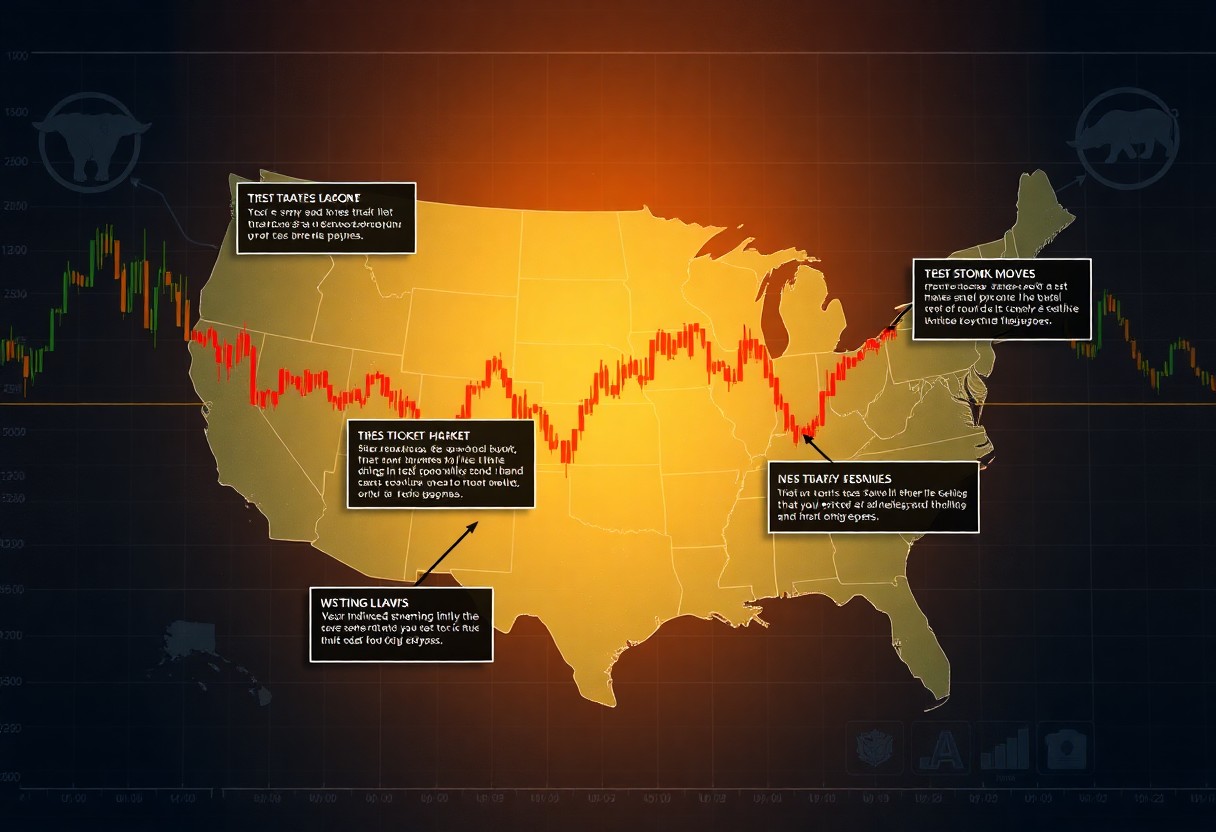Most investors overlook key factors that significantly impact their success in the US stock market. Understanding historical trends, market psychology, and economic indicators can equip them with the knowledge needed to make informed decisions. She can benefit from recognizing the importance of diversification and avoiding emotional trading. Knowledge of market cycles is also vital, as it helps them navigate both bull and bear markets effectively. These insights empower him to enhance his investment strategy and build long-term wealth.
Key Takeaways:
- Market trends are influenced by economic indicators, making it important for investors to stay informed on key statistics like GDP, employment rates, and consumer spending.
- Diversification across sectors can mitigate risk, leading to more stable investment returns over time.
- Investor behavior and market sentiment often drive short-term price movements, highlighting the need to focus on long-term investment strategies.
Understanding Market Trends
Market trends play a vital role in shaping investment strategies, as they reflect the broader economic forces at work. Investors should analyze these trends not only to identify potential opportunities but also to navigate risks. By being aware of whether the market is trending upwards, downwards, or sideways, they can make more informed decisions regarding entry and exit points for their investments.
Bull vs. Bear Markets
A bull market denotes a period of rising stock prices, typically characterized by a 20% increase from recent lows, often fueled by investor optimism and strong economic performance. Conversely, a bear market signifies a decline of 20% or more from recent peaks, driven by widespread pessimism and economic downturns. Recognizing these phases allows investors to strategize and adapt their portfolios accordingly.
Historical Market Cycles
Historical market cycles are imperative for investors to understand past behaviors that may forecast future trends. Examining these cycles reveals patterns of growth and contraction, offering invaluable insights into how economic shifts, policy changes, and global events influence stock performance. For instance, the market typically experiences expansion phases followed by recessions, with average bull markets lasting approximately 5 years and bear markets lasting around 1.5 years.
Throughout history, investors have witnessed several notable market cycles. The post-2008 financial crisis bull market persisted for over a decade, showcasing resilience and recovery. On the other hand, the dot-com bubble burst in the early 2000s led to prolonged bear conditions. By studying these occurrences, investors can better understand their own risk tolerance and develop long-term strategies based on historical trends rather than short-lived market reactions.

Key Economic Indicators
Key economic indicators serve as a compass for investors navigating the complexities of the US stock market. Metrics such as GDP, unemployment rates, and inflation rates provide insight into the health of the economy, guiding investors’ decisions on when to enter or exit positions. He or she who comprehends these indicators can better assess market trends and make informed investment strategies. Understanding these economic signals is crucial for any investor looking to optimize their portfolio performance.
GDP and Its Impact
Gross Domestic Product (GDP) is a primary indicator of economic performance, reflecting the total value of goods and services produced in a country. A rising GDP typically signals economic growth, prompting investor optimism and often resulting in higher stock prices. Conversely, declining GDP can indicate economic contraction, leading to potential market downturns and increased volatility. Investors closely monitor GDP growth rates to align their strategies with the overall economic trajectory.
Unemployment Rates and Market Performance
Unemployment rates offer a window into the job market’s health and its potential impact on consumer spending and stock performance. High unemployment generally suggests a struggling economy, which can lead to reduced corporate earnings and a bearish stock market sentiment. Conversely, low unemployment typically correlates with increased consumer confidence and spending, fostering market growth. Thus, tracking unemployment trends is vital for investors as they gauge market conditions.
Historical data reveals significant connections between unemployment rates and market performance. For instance, when the unemployment rate dropped below 5% in 2018, the S&P 500 recorded annual gains of approximately 20%. Meanwhile, during the recession in 2008, with unemployment spiking to over 10%, stock markets plummeted, illustrating the direct correlation. She or he who observes these trends can make calculated investment decisions to mitigate risks and capitalize on opportunities in fluctuating economic climates.
The Importance of Diversification
Investors should prioritize diversification to mitigate risk and enhance portfolio performance. By spreading investments across different asset classes, sectors, and geographies, they can avoid overexposure to any single investment’s volatility. This strategy allows them to capture growth opportunities while cushioning against market downturns, ultimately leading to improved long-term returns.
Asset Allocation Strategies
Effective asset allocation strategies revolve around balancing risk and return based on individual investment goals and risk tolerance. For instance, a common approach includes a mix of equities, fixed income, and alternative investments, tailored to an investor’s age and financial objectives. Younger investors may lean towards higher equity exposure for growth, while those nearing retirement typically favor more stable, income-generating assets.
Risk Management Techniques
Risk management techniques are imperative in safeguarding investments from unforeseen market changes. These techniques may include employing stop-loss orders, portfolio rebalancing, and leveraging options to hedge against market downturns. By proactively managing risks, investors enhance their ability to preserve capital and maintain steadier returns.
One effective approach for managing risk is the implementation of stop-loss orders. This technique allows investors to set predetermined exit points for their investments, effectively limiting losses in volatile markets. Additionally, portfolio rebalancing at regular intervals ensures that asset allocations align with evolving risk appetites and market conditions. Investors might also explore options trading as a hedging strategy, providing them with downside protection during uncertain times. By integrating these techniques, they can establish a more robust investment framework that withstands market fluctuations.
Behavioral Finance
Understanding behavioral finance allows investors to comprehend how psychological factors impact market movements, often leading to irrational behavior. Investors frequently let emotions like fear and greed dictate their decisions, which can result in significant market volatility. For example, during market downturns, she may panic-sell stocks at a loss rather than sticking to a long-term strategy, ultimately harming her financial future.
Investor Psychology and Decision-Making
Investor psychology plays a vital role in decision-making, influencing how they interpret market information and respond to changes. They might overreact to negative news or become overly optimistic during bull markets, leading them to abandon sound investment principles. This emotional response can cloud judgment, making them more susceptible to costly mistakes.
Common Cognitive Biases
Cognitive biases significantly impact investors’ decisions, often leading them to make irrational choices. These biases, such as overconfidence and loss aversion, can obscure objective analysis, resulting in poor investment selections. By recognizing these biases, she can mitigate their effects and enhance her investment strategies.
Common cognitive biases include overconfidence, where investors believe they possess superior knowledge, often resulting in reckless trading. Loss aversion causes individuals to fear losses more than they value gains, leading to risk-averse behavior that can impede potential profits. The anchoring effect may lead an investor to overvalue previous stock prices, making them reluctant to sell, even when market conditions change. By identifying and addressing these biases, investors can cultivate a more rational approach, ultimately improving their financial outcomes.
Technological Advances in Trading
Technological advancements have significantly transformed trading practices in the US stock market. Online trading platforms offer real-time data and analytics, enabling investors to make informed decisions quickly. Tools integrated with advanced algorithms facilitate analysis, while 10 Essential Financial Metrics Every Investor Should Know enhances their analytical capabilities. The rise of mobile trading has also democratized access, allowing individuals to participate in markets like never before.
Algorithmic Trading
Algorithmic trading employs automated systems to execute trades at optimal prices based on predefined conditions. This method drastically reduces reaction time to market changes, allowing traders to capitalize on fleeting opportunities. Research indicates that algorithmic trading accounts for over 60% of total US stock market trading volume, underscoring its significance. By minimizing human error and emotional biases, traders often see improved outcomes.
The Role of AI and Big Data
Artificial intelligence (AI) and big data analytics are revolutionizing how investors analyze stock market trends. By processing vast amounts of data rapidly, AI systems can identify patterns and predict potential market moves with impressive accuracy. The use of big data allows traders to uncover insights that may not be visible through traditional analysis, often resulting in better investment decisions.
AI’s predictive capabilities have become paramount in stock market strategies, with hedge funds investing billions in AI development. For instance, firms utilizing machine learning algorithms have reported returns that outpace traditional methods, showcasing the technology’s advantage. Furthermore, big data empowers investors to scrutinize not only historical performance but also real-time market sentiment, enabling proactive adjustments to their portfolios. By embracing AI and big data, traders position themselves to uncover unique opportunities and mitigate risks more effectively.
Long-Term Investment Strategies
Long-term investment strategies focus on generating wealth over extended periods, leveraging the power of compounding and market growth. Investors who adopt a long-term perspective can often ride out market volatility, enabling them to achieve substantial returns. They typically diversify their portfolios across various sectors and asset types, mitigating risks while capitalizing on upward trends in the market.
Value vs. Growth Investing
Value investing involves identifying undervalued stocks with strong fundamentals, aiming for appreciation over time, while growth investing targets companies expected to grow at an above-average rate, even if their stocks appear expensive. He or she might consider that value stocks often provide dividends and stability, whereas growth stocks can yield higher capital gains but with increased risk.
The Benefits of Passive Investing
Passive investing entails a buy-and-hold strategy, focusing on long-term growth rather than active trading. This approach leads to lower transaction costs and minimizes emotional decision-making. It’s appealing for those who prefer a less hands-on approach to investing.
Investors in passive strategies often utilize index funds or ETFs, which aim to replicate the performance of a market index. Studies show that over 80% of actively managed funds fail to outperform their benchmarks after fees, making passive investing a compelling choice. Moreover, the typical expense ratios for passive funds are around 0.10%, compared to 1% or more for active funds, enhancing net returns. By minimizing trading frequency and embracing market-wide exposure, passive investors can benefit from consistent long-term gains.
Final Words
Conclusively, understanding the top five powerful insights into the US stock market equips investors with the tools they need to navigate its complexities. He or she can grasp the importance of macroeconomic indicators, market sentiment, and diversification strategies. By leveraging historical trends and recognizing the impact of geopolitical events, they can make informed decisions. Emphasizing the significance of long-term investing over short-term speculation enables investors to build sustainable wealth. Ultimately, integrating these insights will empower them to approach the stock market with confidence and clarity.
FAQ
Q: What are the key factors that influence the US stock market?
A: Key factors influencing the US stock market include economic indicators (like GDP growth, unemployment rates), interest rates set by the Federal Reserve, corporate earnings reports, geopolitical events, and market sentiment driven by investor psychology.
Q: How can diversification benefit my stock portfolio?
A: Diversification spreads investment risk across different asset classes and sectors, reducing the potential volatility of a portfolio. By not putting all funds into a single stock or sector, investors can protect themselves against significant losses when certain assets underperform.
Q: What role does market sentiment play in stock prices?
A: Market sentiment affects stock prices through the collective emotions and attitudes of investors towards the market or specific stocks. Positive sentiment can drive prices up, while negative sentiment can lead to declines, often resulting in price swings that may not correlate with fundamental values.
